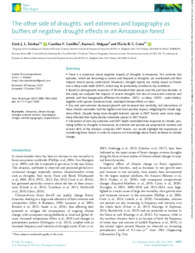The other side of droughts: wet extremes and topography as buffers of negative drought effects in an Amazonian forest.
The other side of droughts: wet extremes and topography as buffers of negative drought effects in an Amazonian forest.
Autoria: ESTEBAN, E. J. L.; CASTILHO, C. V. de; MELGACO, K. L.; COSTA, F. R. C.
Resumo: There is a consensus about negative impacts of droughts in Amazonia. Yet, extreme wet episodes, which are becoming as severe and frequent as droughts, are overlooked and their impacts remain poorly understood. Moreover, drought reports are mostly based on forests over a deep water table (DWT), which may be particularly sensitive to dry conditions. Based on demographic responses of 30 abundant tree species over the past two decades, in this study we analyzed the impacts of severe droughts but also of concurrent extreme wet periods, and how topographic affiliation (to shallow - SWTs - or deep - DWTs - water tables), together with species functional traits, mediated climate effects on trees. Dry and wet extremes decreased growth and increased tree mortality, but interactions of these climatic anomalies had the highest and most positive impact, mitigating the simple negative effects. Despite being more drought-tolerant, species in DWT forests were more negatively affected than hydraulically vulnerable species in SWT forests. Interaction of wet-dry extremes and SWT depth modulated tree responses to climate, providing buffers to droughts in Amazonia. As extreme wet periods are projected to increase and at least 36% of the Amazon comprises SWT forests, our results highlight the importance of considering these factors in order to improve our knowledge about forest resilience to climate change.
Ano de publicação: 2021
Tipo de publicação: Artigo de periódico
Unidade: Embrapa Roraima
Palavras-chave: Amazonia, Climate change, Drought, Topography, Tropical forests
Observações
1 - Por padrão são exibidas publicações dos últimos 20 anos. Para encontrar publicações mais antigas, configure o filtro ano de publicação, colocando o ano a partir do qual você deseja encontrar publicações. O filtro está na coluna da esquerda na busca acima.
2 - Para ler algumas publicações da Embrapa (apenas as que estão em formato ePub), é necessário ter, no celular ou computador, um desses softwares gratuitos. Sistemas Android: Google Play Livros; IOS: iBooks; Windows e Linux: software Calibre.
Acesse outras publicações
Acesse a Base de Dados da Pesquisa Agropecuária (BDPA) para consultar o acervo completo das bibliotecas da Embrapa.

